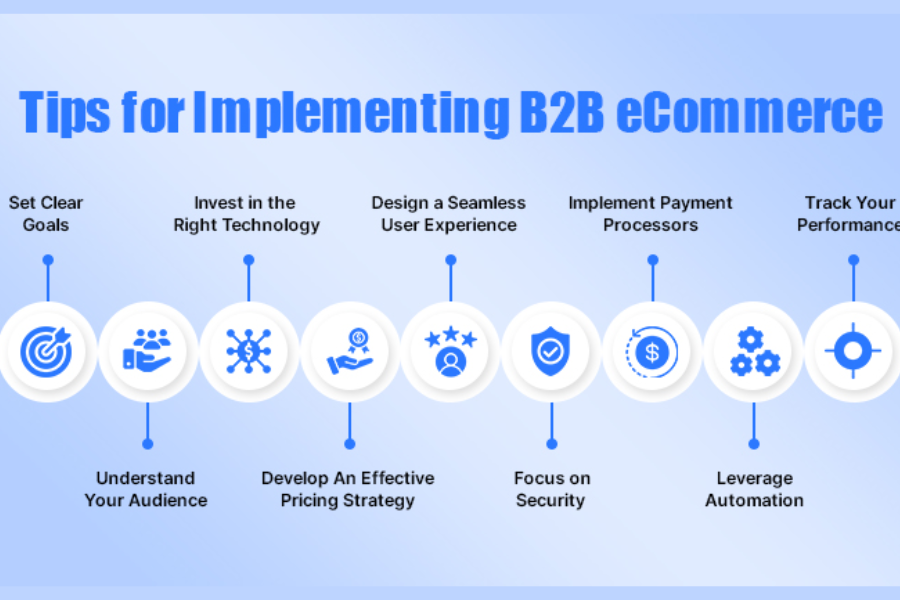Digitallitmus, spotler, gilroy, pearllemon, and Würth represent five distinct B2B companies that have all embraced a common strategy: leveraging digital transformation to enhance customer satisfaction, boost revenue, and improve their bottom lines.
Their commitment to digital transformation is driven by several factors. Rapid digitalization, the increasing use of AI technologies, and challenges such as unstable supply chains and rising energy and commodity prices, exacerbated by geopolitical and economic turbulence, are significantly impacting daily operations for manufacturers and wholesalers.
Excited to explore all about it? Let us walk you through it!
What is Digital Transformation in B2B?
Digital transformation in B2B is more than a buzzword—it’s a revolution that’s changing the way businesses connect, operate, and grow in today’s fast-paced world. It’s about embedding digital technologies into every aspect of a company’s operations, fundamentally transforming how they deliver value and stay competitive.
Picture a company that used to rely on handshakes and phone calls to close deals. Now, thanks to digital transformation, that same company is using advanced e-commerce platforms, AI-driven insights, and automated customer service to engage clients more efficiently and effectively. It’s not just about adopting new technologies—it’s about crafting a seamless, integrated experience that meets the ever-changing needs of customers.
Here’s how digital transformation is making waves in the B2B world:
- Enhanced Customer Experience: Imagine knowing exactly what your customers want before they even ask. By leveraging data and AI, companies can offer personalized experiences, anticipate customer needs, and respond quickly, making the customer journey more satisfying and engaging.
- Streamlined Operations: Think of all the time wasted on repetitive tasks. Automation and digital tools take over these tasks, reducing costs and improving accuracy. This means businesses can focus on what really matters: innovation and strategic growth.
- Improved Decision-Making: With advanced analytics, businesses gain deep insights into market trends, customer behaviors, and operational performance. This leads to smarter, data-driven decisions that drive success.
- Agility and Flexibility: The business world is unpredictable. Digital transformation allows companies to quickly adapt to market changes and disruptions, whether it’s a shift in customer preferences or a sudden supply chain issue. It’s about staying nimble and ready for anything.
- New Revenue Streams: Digital platforms open new sales channels and business models, expanding market reach and creating opportunities for growth. It’s like opening the door to a world of new possibilities.
According to a recent McKinsey report, e-commerce has soared as the top B2B sales channel, with 35% of respondents rating it the most effective. This surpasses traditional methods like in-person sales, video conferencing, email, and phone calls.
It’s about building stronger relationships, offering better services, and staying ahead in a world where change is the only constant.
6 Steps for Implementing Your Digital Strategy
Setting sail on your digital strategy journey is like embarking on a grand adventure—a thrilling quest filled with promise and potential. But like any great odyssey, it requires careful planning and a human touch to navigate the seas of digital transformation. Here are six steps to help you chart your course with confidence and compassion:
- Define Your Vision: Every great journey begins with a vision—a beacon of light guiding you through stormy seas. Take the time to envision what success looks like for your digital strategy. What are your goals? How will digital transformation empower your team and delight your customers? Let your vision be your North Star, guiding you toward a brighter future.
- Know Your Audience: Just as a seasoned captain knows the currents and winds, you must understand the hopes and dreams of those you serve. Dive deep into the hearts and minds of your audience. Who are they? What keeps them up at night? Use empathy and understanding to tailor your digital strategy to meet their needs and exceed their expectations.
- Audit Your Assets: Before you set sail, take inventory of your ship and crew. What digital tools, technologies, and talents do you already possess? Celebrate your strengths and shore up your weaknesses. Consider what additional resources you may need to acquire or develop along the way to ensure a smooth voyage.
- Craft Your Plan: With your vision as your guide and your crew at your side, it’s time to plot your course. Develop a comprehensive plan that outlines the steps you’ll take to achieve your digital goals. Set clear objectives, establish timelines, and allocate resources wisely. But remember, plans are meant to be flexible—be open to new discoveries and detours along the way.
- Act: With the wind in your sails and the on your face, it’s time to set forth on your digital adventure. Act with purpose and passion, leveraging the unique talents and perspectives of your crew. Stay agile and adaptable, ready to navigate challenges and seize opportunities as they arise.
- Measure and Adapt: As you journey forth, keep a steady hand on the helm and an eye on the horizon. Measure your progress against your goals, using key performance indicators to gauge success. Celebrate your victories and learn from your setbacks. And remember, the true measure of success lies not just in reaching your destination, but in the growth and transformation you experience along the way.
With these six steps as your guiding star and the human touch of empathy and understanding, you’re ready to embark on your digital strategy journey with courage and compassion, partnering perhaps with an experienced Ecommerce Agency to navigate the complexities of online business.
Conclusion
Embarking on a digital transformation journey is an exciting and transformative experience for B2B companies like digitallitmus, spotler, gilroy, pearllemon, Würth and RVS Media. This isn’t just about adopting the latest technologies—it’s about reshaping how you connect with your customers, streamline your operations, and grow your business in a rapidly changing world.
By understanding your audience deeply, using data and AI to create personalized experiences, automating repetitive tasks, and staying flexible in the face of change, you can unlock new levels of efficiency and customer satisfaction. The six steps we’ve outlined—defining your vision, knowing your audience, auditing your assets, crafting your plan, acting, and measuring and adapting—serve as a trusted guide to help you navigate this journey.
As you move forward, remember that success isn’t just about reaching your digital goals. It’s also about the growth and transformation you and your team experience along the way. Embrace this journey with an open heart and mind, and you’ll find yourselves not just keeping pace with the digital world but leading the way.
Here’s to a successful and fulfilling digital transformation journey. Bon voyage!
Don’t miss the latest news and updates visit: Gossips!




